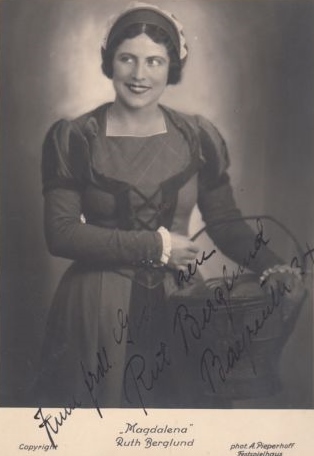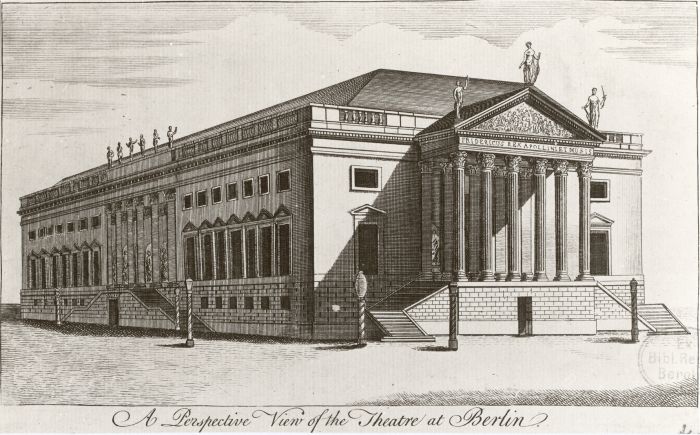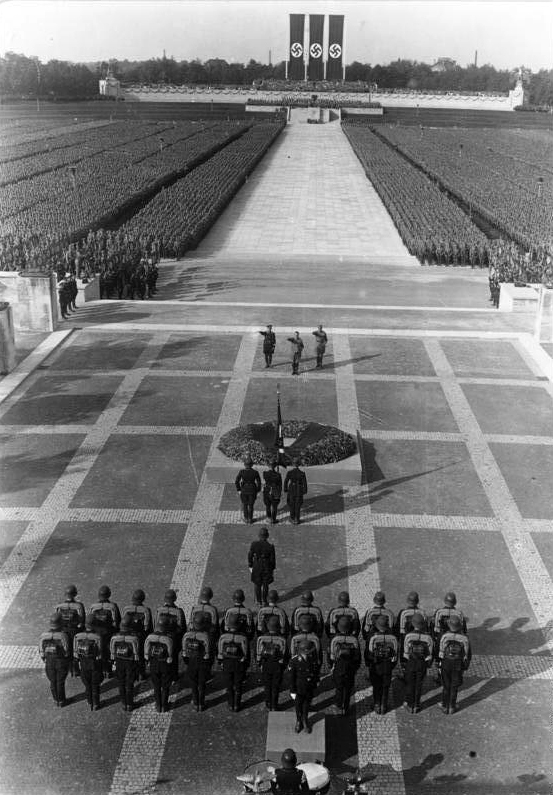|
Rut Berglund
Rut Berglund, also Ruth Berglund (12 April 1897 – 29 August 1984) was a Swedish operatic mezzo-soprano and contralto, who was engaged in Germany from 1924 to 1944. She was personally appointed Kammersängerin by Adolf Hitler. Life and career Born in Åmål, Berglund studied singing with Gillis Bratt in Stockholm and with Ernst Grenzebach in Berlin. In the 1924–25 season she was engaged as a volunteer at the Theater des Westens in Berlin, but due to hyperinflation the house was closed in 1925. The singer subsequently made her debut at the Deutsche Oper Berlin, received a permanent engagement at this house and remained a member of the ensemble until 1932. Berglund married the surgeon Nathanael Wessén in 1927, the wedding took place in the church of her home town Åmål. In 1929 she took part in performances of Wagner's '' Der Ring des Nibelungen'' at the Grand Théâtre de Genève. In the season 1932-33 she was engaged at the Stadttheater Königsberg in East Prussia. At t ... [...More Info...] [...Related Items...] OR: [Wikipedia] [Google] [Baidu] |
Rut Berglund
Rut Berglund, also Ruth Berglund (12 April 1897 – 29 August 1984) was a Swedish operatic mezzo-soprano and contralto, who was engaged in Germany from 1924 to 1944. She was personally appointed Kammersängerin by Adolf Hitler. Life and career Born in Åmål, Berglund studied singing with Gillis Bratt in Stockholm and with Ernst Grenzebach in Berlin. In the 1924–25 season she was engaged as a volunteer at the Theater des Westens in Berlin, but due to hyperinflation the house was closed in 1925. The singer subsequently made her debut at the Deutsche Oper Berlin, received a permanent engagement at this house and remained a member of the ensemble until 1932. Berglund married the surgeon Nathanael Wessén in 1927, the wedding took place in the church of her home town Åmål. In 1929 she took part in performances of Wagner's '' Der Ring des Nibelungen'' at the Grand Théâtre de Genève. In the season 1932-33 she was engaged at the Stadttheater Königsberg in East Prussia. At t ... [...More Info...] [...Related Items...] OR: [Wikipedia] [Google] [Baidu] |
Staatsoper Unter Den Linden
The (), also known as the Berlin State Opera (german: Staatsoper Berlin), is a listed building on Unter den Linden boulevard in the historic center of Berlin, Germany. The opera house was built by order of Prussian king Frederick the Great from 1741 to 1743 according to plans by Georg Wenzeslaus von Knobelsdorff in the Palladian style. Damaged during the Allied bombing in World War II, the former Royal Prussian Opera House was rebuilt from 1951 to 1955 as part of the Forum Fridericianum square. Nicknamed ''Lindenoper'' in Berlin, it is "the first theater anywhere to be, by itself, a prominent, freestanding monumental building in a city." History Names Originally called the ''Königliche Oper'' (Royal Opera) from 1743, it was renamed as the ''Preußische Staatsoper'' (Prussian State Opera) in 1919, then as the ''Deutsche Staatsoper '' in 1955. Until 1990, it housed the state opera of East Germany. Since 1990, it is officially called the ''Staatsoper Unter den Linden'' (State Ope ... [...More Info...] [...Related Items...] OR: [Wikipedia] [Google] [Baidu] |
Der Rosenkavalier
(''The Knight of the Rose'' or ''The Rose-Bearer''), Op. 59, is a comic opera in three acts by Richard Strauss to an original German libretto by Hugo von Hofmannsthal. It is loosely adapted from the novel ''Les amours du chevalier de Faublas'' by Louvet de Couvrai and Molière's comedy ''Monsieur de Pourceaugnac''. It was first performed at the Königliches Opernhaus in Dresden on 26 January 1911 under the direction of Max Reinhardt, Ernst von Schuch conducting. Until the premiere, the working title was ''Ochs auf Lerchenau''. (The choice of the name Ochs is not accidental, for in German "Ochs" means "ox", which describes the character of the Baron throughout the opera.) The opera has four main characters: the aristocratic Marschallin; her very young lover, Count Octavian Rofrano; her brutish cousin Baron Ochs; and Ochs' prospective fiancée, Sophie von Faninal, the daughter of a rich bourgeois. At the Marschallin's suggestion, Octavian acts as Ochs' ''Rosenkavalier'' by pre ... [...More Info...] [...Related Items...] OR: [Wikipedia] [Google] [Baidu] |
Total Wartime Deployment Of The Cultural Workers
The Total wartime deployment of the cultural workers (Totale Kriegseinsatz der Kulturschaffenden), popularly known as ''Theatersperre'', was a decree by Joseph Goebbels in his function as ''Reichsbevollmächtiger für den totalen Kriegseinsatz'' of 24 August 1944, which came into force on 1 September 1944. This resulted in the closure of almost all German and Austrian theaters and cultural institutions. Artists who were not on the so-called "Gottbegnadeten" were also called upon to important war activities. The singer Anneliese Rothenberger, for example, had to work in a tinplate can factory after the closure of the Theater Koblenz. Historical processing The theatre closure has hardly been historically reconstructed so far: Austria Already on 8 March 1943, Hitler ordered: "The Bayreuth Festival will take place on the same scale as last year. The Salzburg Festival will not take place. Instead, Salzburg Theatre Weeks are to be organized, in which the armament workers and w ... [...More Info...] [...Related Items...] OR: [Wikipedia] [Google] [Baidu] |
Paul Graener
Paul Graener (11 January 1872 – 13 November 1944) was a German composer and conductor. He composed numerous operas and orchestral works in the Romanticism style. Biography Graener was born in Berlin and orphaned as a young child. A boy soprano, he taught himself composition and in 1896 moved to London, where he gave private lessons and served briefly as conductor at the Haymarket Theatre. Before the move, he had married Maria Elisabeth Hauschild, who bore him three children in London. Graener is recorded in the United Kingdom Census of 1901 as a "musical director (theatre)" living at 3 Poplar Grove in Hammersmith together with Maria (born in Kiel), their first two children (Heinz and Paul, aged 4 and 2) and Graener's author cousin, George. In around 1910, Graener moved to Vienna, where he took up a teaching post at the Neues Wiener Konservatorium. He moved several times in the 1910s, living in Salzburg, Dresden and Munich, eventually accepting the position of professor o ... [...More Info...] [...Related Items...] OR: [Wikipedia] [Google] [Baidu] |
Deutsches Historisches Museum
The German Historical Museum (german: Deutsches Historisches Museum), known by the acronym DHM, is a museum in Berlin, Germany devoted to German history. It describes itself as a place of "enlightenment and understanding of the shared history of Germans and Europeans". It is often viewed as one of the most important museums in Berlin and is one of the most frequented. The museum is located in the Zeughaus (armoury) on the Unter den Linden as well as in the adjacent Exhibition Hall designed by I. M. Pei. The German Historical Museum is under the legal form of a foundation registered by the Federal Republic of Germany. Its highest-ranking body is the Board of Trustees (Kuratorium) with representatives of the federal government, the German Bundestag (Parliament) and the governments of the German Länder, or states. Founding and history The museum was founded on 28 October 1987, on the occasion of the 750th anniversary of the founding of Berlin; it was inaugurated in the Reichst ... [...More Info...] [...Related Items...] OR: [Wikipedia] [Google] [Baidu] |
Staatstheater Nürnberg
The Staatstheater Nürnberg is a German theatre company in Nuremberg, Bavaria. The theatre is one of four Bavarian state theatres and shows operas, plays, ballets and concerts. History Its main venue, the opera house ("Opernhaus Nürnberg"), is one of the largest theatres in Germany. It was built from 1903 to 1905 in Art Nouveau style by the architect Heinrich Seeling. Until 1 January 2005, it was known as the "Städtische Bühnen Nürnberg". Other venues are the play house (''Schauspielhaus Nürnberg'') including the small stages "Kammerspiele" and "BlueBox", and the Meistersingerhalle where the concerts of the orchestra (the Staatsphilharmonie Nürnberg) are held. Since 2018, the company's ''Generalmusikdirektorin'' (General Music Director) is Joana Mallwitz. Her initial contract, announced in October 2017, was for 5 years. She is the first female conductor to be named GMD of the company. In July 2021, the company announced that Mallwitz is to stand down as its GMD at ... [...More Info...] [...Related Items...] OR: [Wikipedia] [Google] [Baidu] |
Reichsparteitag
The Nuremberg Rallies (officially ', meaning ''Reich Party Congress'') refer to a series of celebratory events coordinated by the Nazi Party in Germany. The first rally held took place in 1923. This rally was not particularly large or impactful; however, as the party grew in size, the rallies became more elaborate and featured larger crowds. They played a seminal role in Nazi propaganda events, conveying a unified and strong Germany under Nazi control. The rallies became a national event once Adolf Hitler rose to power in 1933, when they became annual occurrences. Once the Nazi dictatorship was firmly established, the party's propagandists began filming them for a national and international audience. Nazi filmmaker Leni Riefenstahl produced some of her best known work including ''Triumph of the Will'' (1934) and ''The Victory of Faith'' (1933), both filmed at the Nazi party rally grounds near Nuremberg. The party's 1938 Nuremberg rally celebrated the Anschluss that occurred ear ... [...More Info...] [...Related Items...] OR: [Wikipedia] [Google] [Baidu] |
Wilhelm Furtwängler
Gustav Heinrich Ernst Martin Wilhelm Furtwängler ( , , ; 25 January 188630 November 1954) was a German conductor and composer. He is widely regarded as one of the greatest symphonic and operatic conductors of the 20th century. He was a major influence for many later conductors, and his name is often mentioned when discussing their interpretative styles. Furtwängler was principal conductor of the Berlin Philharmonic between 1922 and 1945, and from 1952 until 1954. He was also principal conductor of the Gewandhaus Orchestra (1922–26), and was a guest conductor of other major orchestras including the Vienna Philharmonic. Although not an adherent of Nazism, he was the leading conductor to remain in Germany during the Nazi regime. Despite his open opposition to antisemitism and the ubiquity of Nazi symbolism, the regime did not seek to suppress him, at Joseph Goebbels' insistence, for propaganda reasons. This situation caused lasting controversy, and the extent to which his pr ... [...More Info...] [...Related Items...] OR: [Wikipedia] [Google] [Baidu] |
Bayreuth Premiere Cast Of Parsifal
The Bayreuth premiere cast of Parsifal lists the contributors to the new productions of Richard Wagner's inaugural stage play ''Parsifal'', including the premiere, which took place on 26 July 1882 at the Bayreuth Festival. About the performance history In the last performance of the premiere series in 1882, Richard Wagner personally took over the baton from Hermann Levi in Act III, unnoticed by the audience, since the overbuilt orchestra pit of the Festspielhaus made the conductor and the orchestra invisible to the public. It was the only time the composer conducted in his house himself. ''Parsifal'' was composed especially for the Bayreuth Festival Theatre and, as Wagner stated in a letter to King Ludwig II of Bavaria in 1880, was to be performed there exclusively. The premiere production was virtually sacrosanct in Bayreuth and remained almost unchanged on the festival programme for 51 years. Hermann Levi remained conductor until 1894, only in 1888 (and then in 1897) Felix M ... [...More Info...] [...Related Items...] OR: [Wikipedia] [Google] [Baidu] |
Camille Saint-Saëns
Charles-Camille Saint-Saëns (; 9 October 183516 December 1921) was a French composer, organist, conductor and pianist of the Romantic music, Romantic era. His best-known works include Introduction and Rondo Capriccioso (1863), the Piano Concerto No. 2 (Saint-Saëns), Second Piano Concerto (1868), the Cello Concerto No. 1 (Saint-Saëns), First Cello Concerto (1872), ''Danse macabre (Saint-Saëns), Danse macabre'' (1874), the opera ''Samson and Delilah (opera), Samson and Delilah'' (1877), the Violin Concerto No. 3 (Saint-Saëns), Third Violin Concerto (1880), the Symphony No. 3 (Saint-Saëns), Third ("Organ") Symphony (1886) and ''The Carnival of the Animals'' (1886). Saint-Saëns was a musical prodigy; he made his concert debut at the age of ten. After studying at the Paris Conservatoire he followed a conventional career as a church organist, first at Saint-Merri, Paris and, from 1858, La Madeleine, Paris, La Madeleine, the official church of the Second French Empire, Fren ... [...More Info...] [...Related Items...] OR: [Wikipedia] [Google] [Baidu] |







